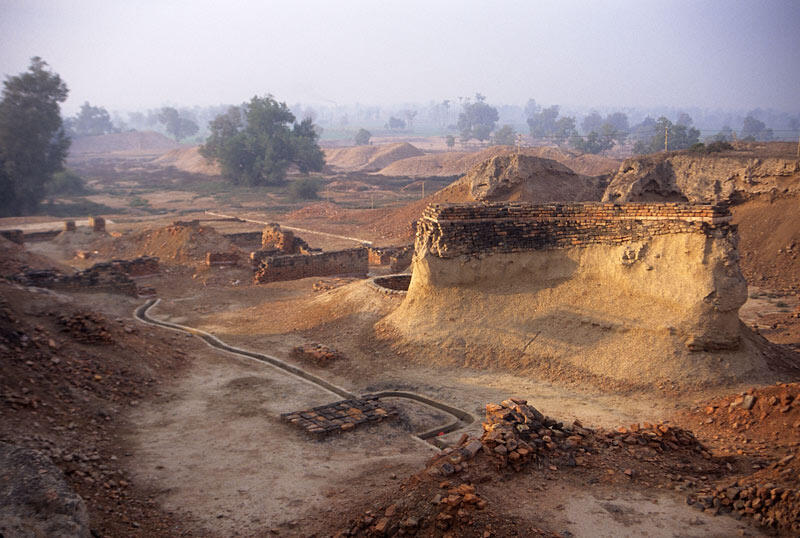This thoughtful and enlightening paper starts with a clear statement of the writer's point-of-view: "On the other hand, to keep writing that Indus society in the 3rd millennium BC was uniform, acephalous, egalitarian and classless, that it was not a state, that its people rejected violence, elites had no palaces, and the Indus signs were not writing, is not only equally conjectural, but also deeply misleading. In the terms of Yoffee (2005) these statements, in fact, are factoids not supported by actual data. Most of these wrong assumptions - incidentally, if not systematically, contested in these pages - are due to a general ignorance of the logic of archaeological excavations and site formation processes in Indus contexts, to partial archaeological reports, or simply to the bias of enduring prejudice, sometimes disguised as last-minute palatable theories (these may appear strong and arbitrary statements, but they will be supported, in what follows, by specific references)" (pp. 2-3).
Indeed, the author agrees with Shereen Ratnagar that "the 'no war' paradigm is doubtless 'a rather silly statement'" (p. 34), but this is far more than a polemical paper. Instead the author uses the evidence from excavations at Harappa, "whose evidence provided the backbone of this paper" (p. 5), to argue that the Indus civilization could have developed and been managed by trading and manufacturing groups, based on a combination of kinship and trading interests. The importance of external trade (other civilizations and other towns, cities and regions from which raw materials were brought is stressed, as is the archaeological evidence of walled areas within a city like Harappa where specific craft activities were located. He writes about Harappa: "There is little doubt that the key for understanding the inner nature of Indus urbanism came from the excavations at Harappa (1986- 2001). I feel that still few scholars realize how crucial and disruptive of previous interpretations this project has been. Combining for the first time medium-sized exposures with a careful stratigraphic control, Kenoyer established the relative chronology of the main walled compounds of Harappa" (pp. 7-8).
The author uses the medieval city of Genoa in Italy as a model for how this might have operated, where specific craft and trade groups managed areas of town and external relationships and cooperated through structures where different groups had greater authority at different points within an independent framework. He is not saying that Indus cities were identical to Genoa, only that we need better models through which to think about how a broader Indus civilization could have emerged from different groups, cities and interests without having to resort to top-down, authoritarian, state or royalty models; there is too much diversity as well as separateness within cities that could have been managed in different ways than we usually assume. There certainly is evidence for hierarchy of some sort, as in manufactured goods in different materials that likely signaled wealth or status. Still, he rejects simplistic views, including discussions of so-called "citadels" in Indus cities, where he agrees with Dr. Mark Kenoyer: "Actually, Indus so-called "citadels‟, in all the tested cases, are higher and look more massively fortified only because they were built on top of previous walled mounds built in the first half of the 3rd millennium BC (further comments in Vidale 2019)."
Dr. Vidale uses the evidence of seals to argue that these could have provided "a medium of horizontal connectivity" (p. 15) and discusses how the animal usually depicted was over time replaced by seals and token with only letters or symbols, suggesting greater ability to decipher them among relevant populations. Similarly, the weight system of Indus cities being so uniform could speak to how trade was based on standardized measures (connectivity) but this need not have come from a single authority but the cooperation of multiple authorities in recognizing a standard for exchange without which widespread trade would not be possible or at least easy. The rise and fall of Indus cities in relation to trade and economic relationships with far away areas is used to argue that the flow of goods and people was essential, as with other civilizations, to Indus cities flourishing.
The author sums up his efforts very clearly at the end, and as ever, sees this as a step towards future investigation and discovery: "For the moment, this article, even in its hypothetical terms 1. outlines an articulated model for the development of Indus urbanism, centering on the evidence of diachronic growth processes of its walled compounds; 2. links this unique process, referring to a quite different historical contingency, to possible heterarchical forms of political power, which may have shifted in time from compound to compound; 3. suggests the probability that the heterarchic governments of Indus cities were not necessarily egalitarian and peaceful, as often assumed (not only by the popular press, but also within some academic circles); 4. explains in the same heterarchic agendas the combined role of two crucial communication media (ornaments of scalar values and seals, tokens and micro-tablets), arguing on the possible functions of the compounds‟ guarded gates; 5. suggests that one of economic variables in play was an important role of long-distance trade networks of valuable raw materials needed to produce large amounts of personal ornaments, whose episodic failures left in abandoned craft buildings large amounts of semi-processed goods. Although, at present, this is hypothetical (and even, in not a few aspects, conjectural), it also outlines a complex model that is rather coherent in its material correlates. I believe that even the dismantling of this set of explanations, in future, might push onward the archaeology of this unique and fascinating civilization" (p. 38).
A smart and resonant attempt to open up the models with which we imagine that the Indus civilization existed.
Image: The Central Area of Mound A/B, Harappa

